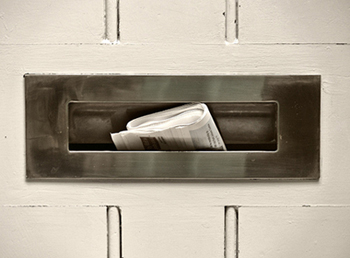Back to Conversion section page

Photo by Rob Gallop
Most first-time visitors to your website will be casual browsers, unlikely to hand over money straight away. But if they like the content on your site, they may well be pleased to sign up for a free subscription, so that you can send them more of the same good stuff. Over time, if you send them enough great content, you can convert these regular subscribers into true fans.
A creator, such as an artist, musician, photographer, craftsperson, performer, animator, designer, videomaker, or author – in other words, anyone producing works of art – needs to acquire only 1,000 True Fans to make a living.
A True Fan is defined as someone who will purchase anything and everything you produce. They will drive 200 miles to see you sing. They will buy the super deluxe re-issued hi-res box set of your stuff even though they have the low-res version. They have a Google Alert set for your name. They bookmark the eBay page where your out-of-print editions show up. They come to your openings. They have you sign their copies. They buy the t-shirt, and the mug, and the hat. They can’t wait till you issue your next work. They are true fans.
…
Assume conservatively that your True Fans will each spend one day’s wages per year in support of what you do. That “one-day-wage” is an average, because of course your truest fans will spend a lot more than that. Let’s peg that per diem each True Fan spends at $100 per year. If you have 1,000 fans that sums up to $100,000 per year, which minus some modest expenses, is a living for most folks.(Kevin Kelly, 1000 True Fans)
Depending on the price of your products or services, you may need more or less than 1000 true fans. But as Kelly points out, it’s not an unfeasibly large number. It’s within your reach.
Seth Godin expressed a similar idea in his latest book Tribes:
There is a tribe of fellow employees or customers or investors or believers or hobbyists or readers just waiting for you to connect them together and lead them where they want to go.
Once you start publishing content, engaging in conversations online and attracting fans, you have an opportunity to become the leader of a tribe — a group of people with common interests and values to you. This can be rewarding for its own sake. Like all creative people, you are probably motivated by other things as well as money. But it also dovetails neatly with one of the well established rules of Internet marketing:

Photo by AMagill
In this context, ‘list’ means a mailing list, made up of people who have given you permission to contact them on a regular basis.
Now, we all know the kind of annoying mailing list that keeps popping up into our e-mail inboxes — the kind you didn’t sign up for, don’t want and can’t find a way to unsubscribe from. That’s not what I’m talking about here.
I’m talking about the other kind of mailing list — the one you signed up for because it looked cool, the one you’re glad to receive, the one you even look forward to receiving. The one you recommend to your friends, because it’s such good stuff.
Seth Godin calls this kind of list a permission asset, since it’s based on people giving active permission to receive messages:
Permission marketing is the privilege (not the right) of delivering
anticipated, personal and relevant messages to people who actually want to get them.(Seth Godin, Permission Marketing)
Creating Permission Assets
One of your biggest goals should be to create one or more high-quality permission assets of this kind. The great thing about a good list is that you can adapt it as your business evolves, as long as you are meeting your audiences needs.
So for example I started building a list of subscribers to Wishful Thinking in order to sell coaching and training to companies, and attract private coaching clients. When I decided to start running my own training events, the blog and my other permission assets (see below) were perfect for getting the word out and selling tickets.
An e-mail newsletter is the classic form of online mailing list, but there are several others you should also consider.
E-mail list
Pros: Handing over an e-mail address shows a high level of trust and commitment — you have a hotline to someone’s inbox, which is a great way to get their attention (as long as you don’t abuse it by sending too many messages or irrelevant ones). Because e-mails are private, an e-mail list can create the sense of being on the ‘inside’, privileged access to special knowledge.
Cons: E-mail is abused so badly that you have to work very hard to avoid being perceived as a spammer. Only this week, I nearly marked an e-mail as ‘spam’ before I remembered that I had in fact signed up for it several months ago. You should never add someone to your mailing list without asking their permission. To manage an e-mail list effectively, you really need to use a professional service, which costs money and can be complicated to operate.
Using a professional mailing service will give your readers the opportunity to confirm that they want to receive your messages, by clicking on a special link that is e-mailed to them right at the beginning. Yes, it means you will have fewer people on your list — but quality is more important than quantity. It’s better to have a few people who are seriously interested in what you have to offer, than annoying thousands of people who will report you as a spammer.
I use Feedblitz to manage my Wishful Thinking e-mail lists, although I wouldn’t recommend them 100%. They offer an excellent delivery service, with all the options I need. But they have the most confusing website I have ever seen! You have been warned.
Aweber is another popular and respected service, which I use on some projects. It’s still complicated, but far easier to use than Feedblitz.
My e-mail lists: I have an events mailing list which will keep you informed of all my upcoming training events (and other secret projects currently in the pipeline). I also have e-mail subscription options on both Wishful Thinking and Lateral Action.
Blog subscribers
Pros: Signing up to read every article published on your blog is a pretty high level of commitment. The other great thing about a blog is that it performs a dual function — firstly as a mailing list, to deliver content to your subscribers; and secondly as a means of generating high-quality content for your website, which will be picked up by search engines and attract new visitors (potential subscribers) to your site. Displaying a high subscriber count on your blog can offer impressive social proof of the value of your website.
Cons: Because blog content is public, it doesn’t feel as intimate as an e-mailing list, and probably represents a lower level of commitment from your subscribers. And as many people subscribe via RSS instead of e-mail, you may never even know who they are.
My blog lists: You can sign up for free updates from Wishful Thinking or Lateral Action. (For an explanation of RSS, see this page.)
Twitter followers
Pros: Twitter is a great way to stay in regular contact with lots of people without being too intrusive. People only see Twitter messages when they actively log on to the service, so unlike e-mail or a phone call, there’s a very low risk of interrupting them in the middle of something important. Because Twitter updates are so frequent, helps you to stay ‘front of mind’ for your audience.
Cons: Because Twitter is so public, and because nobody reads everything published by the people they are following, your Twitter followers will probably have a lower level of commitment to you than your e-mail or blog subscribers.
My Twitter followers: If you’re a Twitter user, you can follow me here. Let me know your Twitter username and I’ll follow you back.
Facebook or MySpace friends
Some people treat their friends on Facebook, MySpace or other social networks as a mailing list, and are quite happy to send out promotional messages to all their friends. I don’t do this, as it annoys me when my ‘friends’ do it to me. Call me old-fashioned, but I think friends are for staying in touch with, not marketing to.
But your experience may be different — I’d love to hear from you if you successfully use your social networking friends for marketing purposes — please drop me an e-mail.
Facebook Group members
A Facebook group or Fan page is very different to a Facebook friendship. You can set up a group or fan page about your business, and send messages to the entire group at once, so that it effectively becomes a mailing list.
Pros: These days, just about everyone is on Facebook, even people who don’t normally use the Internet and would never dream of subscribing to a blog or newsletter. So having a presence on Facebook makes it easy to contact these people. Members are free to leave the group at any time, so as long as they stay, it’s safe to assume they are happy to receive your messages.
Cons: Facebook doesn’t have the intimacy of an e-mail list, and it’s not an ideal medium for publishing content. I’ve said before that Facebook should be one of your outposts, never your Home base.
My Facebook Group: You can join the Wishful Thinking Facebook group here. I don’t send that many messages to it, just when I’ve got something special to announce or an article I’m particularly pleased with and want people to read.

What kind of list(s) do you want to create?
E-mail list
Blog subscribers
Twitter followers
Facebook Group
MySpace Friends